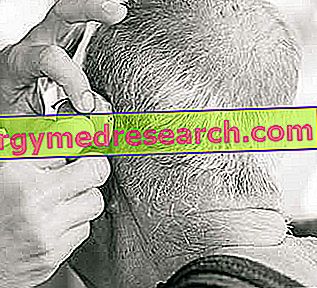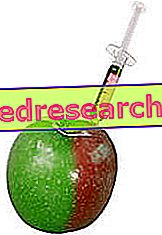Generality
Presbycusis is the reduction or loss of hearing ability, related to aging. Most likely, presbycusis is one of the sensory deficits that occur most commonly in the elderly.

Generally, the hearing impairment that occurs in the case of presbycusis is both qualitative and quantitative, and tends to proceed and evolve rather slowly. Initially, in fact, the patient may find it difficult to perceive only certain types of sounds (usually, the higher frequencies), but later, the reduction in hearing tends to increase and get worse.
Usually, presbycusis becomes a noticeable disorder from the age of 65 onwards and manifests itself with a higher incidence in male patients than in female patients.
Causes
As mentioned, presbyacusis is linked to factors relating to the patient's age. In this regard, it should be pointed out that the reduction in hearing that occurs with advancing age, but whose cause lies in factors other than those linked to senescence processes, cannot be defined as presbycusis. However, very often, it is very difficult to be able to pinpoint exactly which factors are directly responsible for the hearing deficit.
However, with advancing age - therefore with aging - there are several alterations that can occur to the hearing apparatus and which can then lead to the onset of presbycusis. These include:
- Thickening of the tympanic membrane;
- Cell degeneration of the organ of Corti (an organ located in the cochlear duct, responsible for the transmission of the sound impulse at central level);
- Loss of elasticity of the basilar cochlea membrane;
- Reduction in the number of eyelashes present in the auditory system;
- Degenerative processes that occur at the level of the ossicular joints;
- Alteration of the vascular stria that initially occurs at the base and at the apex of the cochlea, to then even reach the central areas;
- Compression of nerve fibers caused by phenomena of hyperostosis.
In light of what has been said, one can guess how presbycusis can be caused by age-related alterations that occur in the inner ear, while those that occur in the middle ear and outer ear seem to have a significant influence lower in the etiology of this age-related form of hearing impairment.
Classification
The different forms of presbycusis currently known can be divided according to the part of the inner ear affected and the consequent type of damage that led to hearing loss.
On the basis of this classification we can therefore distinguish:
- Neural presbycusis, due to alterations of the basilar membrane and characterized by a progressive difficulty in distinguishing the words.
- Sensory presbycusis, characterized by a degeneration that occurs mainly at the cochlear level.
- Strial or metabolic presbycusis, characterized by alterations that can occur at the level of the vascular stria.
- Mixed presbycusis, in which the hearing deficit is caused not by a single pathogenetic mechanism, but by a set of different types of degeneration and alterations that can arise in different districts of the same auditory system;
- Indeterminate presbycusis .
Symptoms and Related Disorders
The initial symptoms of presbycusis are usually mild. In fact, the patient has difficulty in perceiving only certain types of high-frequency sounds and, generally, tends not to give weight to them.
As time goes on, however, the individual finds it difficult to perceive even the sounds at lower frequencies, up to the point of understanding conversations with great difficulty, especially if they occur between several people and / or in the presence of surrounding noise .
Furthermore, it is not uncommon for patients with presbycusis to also suffer from other hearing disorders, such as tinnitus and balance disorders .
Finally, given the marked way in which presbycusis can adversely affect the life of the elderly, patients who suffer from it can often experience social isolation and depressive phenomena .
Diagnosis
The diagnosis of presbycusis can be made accurately through the audiometric examination . In fact, patients suffering from this hearing impairment have a typical increase in the hearing threshold in the high-frequency area, which is highlighted by the tonal audiometric examination.
Furthermore, presbycusis usually occurs bilaterally.
Treatment
Unfortunately, there are no specific drugs or even a definitive cure for the treatment of presbycusis. However, there are some therapeutic approaches that can be followed to try to improve the hearing and communication skills of patients with this disorder.
More in detail, the use of hearing aids and cochlear implants can be used .
Hearing aids are electronic devices capable of detecting sound thanks to the presence of a microphone. The sound is then amplified by a special amplifier and sent to the ear via a speaker.
Cochlear implants are indicated for those who do not benefit from the use of the aforementioned hearing aids; these aids must be inserted surgically into the patient's ear.
While hearing aids simply amplify and convey sound in the ear, cochlear implants are designed to perform the function of the altered or degenerated part of the inner ear, sending the information directly to the cochlear nerve which therefore should not be damaged, but fully functional.
In some cases, moreover, these systems can also be used in association with external hearing aids.
Finally, for the patient suffering from presbycusis, it could be useful to associate the aforementioned therapeutic approaches with auditory rehabilitation which also includes teaching or strengthening the ability to recognize and interpret the lip language .
In any case, it will be the doctor who will establish - on a strictly individual basis - which is the best therapeutic strategy to adopt for each patient, both according to the type of damage that caused the presbyacusis, and according to the degree of severity of the hearing impairment presented by the same patient.



